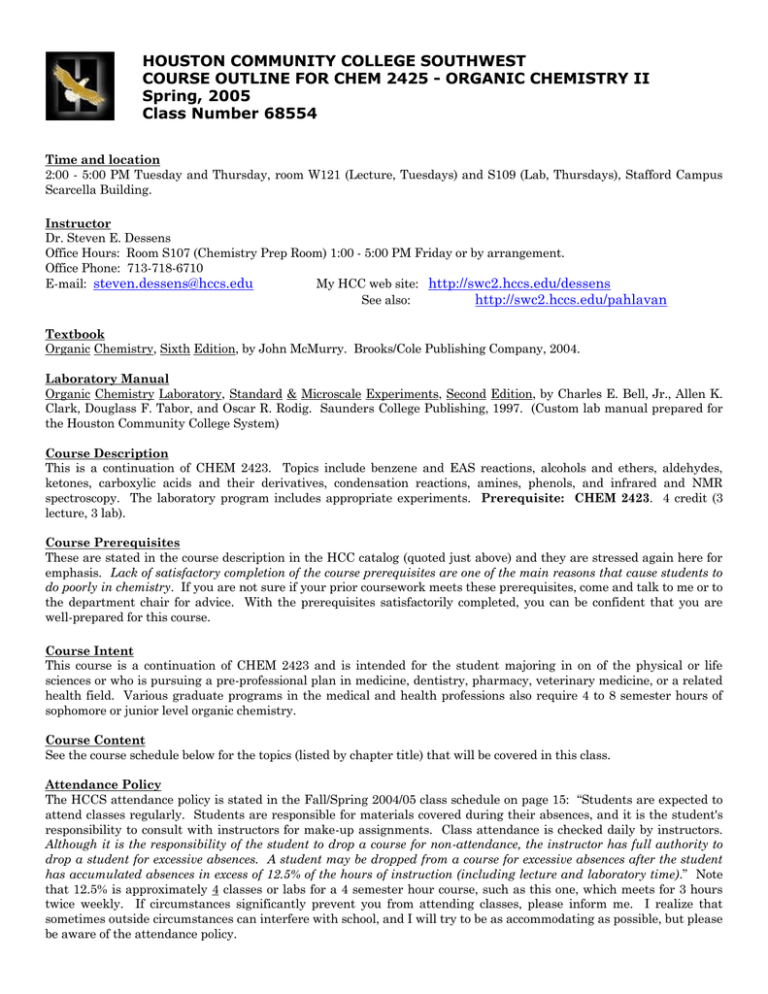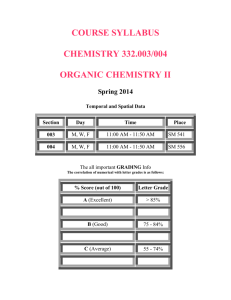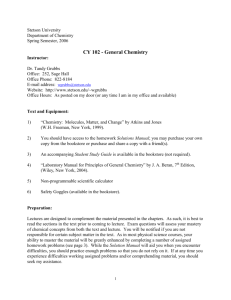HOUSTON COMMUNITY COLLEGE SOUTHWEST Spring, 2005 Class Number 68554
advertisement

HOUSTON COMMUNITY COLLEGE SOUTHWEST COURSE OUTLINE FOR CHEM 2425 - ORGANIC CHEMISTRY II Spring, 2005 Class Number 68554 Time and location 2:00 - 5:00 PM Tuesday and Thursday, room W121 (Lecture, Tuesdays) and S109 (Lab, Thursdays), Stafford Campus Scarcella Building. Instructor Dr. Steven E. Dessens Office Hours: Room S107 (Chemistry Prep Room) 1:00 - 5:00 PM Friday or by arrangement. Office Phone: 713-718-6710 E-mail: steven.dessens@hccs.edu My HCC web site: http://swc2.hccs.edu/dessens See also: http://swc2.hccs.edu/pahlavan Textbook Organic Chemistry, Sixth Edition, by John McMurry. Brooks/Cole Publishing Company, 2004. Laboratory Manual Organic Chemistry Laboratory, Standard & Microscale Experiments, Second Edition, by Charles E. Bell, Jr., Allen K. Clark, Douglass F. Tabor, and Oscar R. Rodig. Saunders College Publishing, 1997. (Custom lab manual prepared for the Houston Community College System) Course Description This is a continuation of CHEM 2423. Topics include benzene and EAS reactions, alcohols and ethers, aldehydes, ketones, carboxylic acids and their derivatives, condensation reactions, amines, phenols, and infrared and NMR spectroscopy. The laboratory program includes appropriate experiments. Prerequisite: CHEM 2423. 4 credit (3 lecture, 3 lab). Course Prerequisites These are stated in the course description in the HCC catalog (quoted just above) and they are stressed again here for emphasis. Lack of satisfactory completion of the course prerequisites are one of the main reasons that cause students to do poorly in chemistry. If you are not sure if your prior coursework meets these prerequisites, come and talk to me or to the department chair for advice. With the prerequisites satisfactorily completed, you can be confident that you are well-prepared for this course. Course Intent This course is a continuation of CHEM 2423 and is intended for the student majoring in on of the physical or life sciences or who is pursuing a pre-professional plan in medicine, dentistry, pharmacy, veterinary medicine, or a related health field. Various graduate programs in the medical and health professions also require 4 to 8 semester hours of sophomore or junior level organic chemistry. Course Content See the course schedule below for the topics (listed by chapter title) that will be covered in this class. Attendance Policy The HCCS attendance policy is stated in the Fall/Spring 2004/05 class schedule on page 15: “Students are expected to attend classes regularly. Students are responsible for materials covered during their absences, and it is the student's responsibility to consult with instructors for make-up assignments. Class attendance is checked daily by instructors. Although it is the responsibility of the student to drop a course for non-attendance, the instructor has full authority to drop a student for excessive absences. A student may be dropped from a course for excessive absences after the student has accumulated absences in excess of 12.5% of the hours of instruction (including lecture and laboratory time).” Note that 12.5% is approximately 4 classes or labs for a 4 semester hour course, such as this one, which meets for 3 hours twice weekly. If circumstances significantly prevent you from attending classes, please inform me. I realize that sometimes outside circumstances can interfere with school, and I will try to be as accommodating as possible, but please be aware of the attendance policy. Last Day for Administrative and Student Withdrawals For 16 week Spring '05 classes, this date is April 7. I urge any student who is contemplating withdrawing from the class to see me first! You may be doing better than you think. Either way, I want to be accessible and supportive. I do not believe in "weed out" classes, and I consider you to be much more than just a name or number! Note my office hours, above; if you need assistance, I'm here to help. Disability Support Services (DSS) If you have any special needs or disabilities which may affect your ability to succeed in college classes or participate in any college programs or activities, please contact the DSS office for assistance. (At Southwest College, contact Dr. Becky Hauri, 713-718-7909; also see page 8 of the Fall/Spring 2004/05 class schedule for additional DSS numbers.) Academic Honesty Students are responsible for conducting themselves with honor and integrity in fulfilling course requirements. Disciplinary proceedings may be initiated by the college system against a student accused of scholastic dishonesty. Penalties can include a grade of "0" or "F" on the particular assignment, failure in the course, academic probation, or even dismissal from the college. Scholastic dishonesty includes, but is not limited to, cheating on a test, plagiarism, and collusion. Laboratory Policy Laboratory rules and safety instructions will be reviewed by the instructor. You should be especially aware of the need for adequate eye protection in the laboratory. Safety glasses or goggles must be worn at all times during the laboratory period. Any student not wearing glasses or goggles after the experiment has begun may be given a zero for that experiment! Laboratory reports are due one week after the experiment. Experiments will be performed in groups of up to three students each. Before you leave the lab, be sure to show me your report sheet so I can review and initial it (SD). Be in the lab on time and be sure to have your lab manual, or a Xerox of the report sheet and the procedure if you are in a financial bind, with you. Laboratory reports are due one week after the experiment. Each report must be done individually; "group reports" and lab reports from different individuals with identical wording are not acceptable! See the accompanying handout which outlines the format of the lab report. Each report will be graded on a 20 point basis. You should come to lab prepared. Read through the experiment beforehand, and answer the pre-lab questions in the lab manual. Keep a bound laboratory notebook (clothbound is standard; spiral is acceptable). This is for you to record your "on the spot" observations, changes to procedure, etc., and general data. The actual report is done separately. Makeup policy for missed labs: None! Exams and Make-up Policy Examinations will consist of three non-cumulative regular exams plus a comprehensive departmental final. Exams are in "show work" format. The final exam is similar but has some multiple choice questions. Make-up exams will not normally be given, so make every effort to take the exams on their scheduled dates. In the event that you must miss a regular exam, I will count the grade made on the final exam as the grade for the missed exam (for one missed exam only), and calculate the final course grade accordingly. If you do not miss any of the regular exams, I will replace your lowest exam score with your final exam score if the final exam grade is higher. This is intended to provide you a "second chance" if you do not do well on a particular exam. Remember that the final exam will be comprehensive (meaning that it will cover all of the material from the whole semester, not just the last part). Please note: 1) All students are required to take the final (no student can be exempted), and 2) A student who completes the course by taking the final exam cannot receive a "W" in the course. In exceptional cases a W can still be given after the withdrawal date, but if you take the final, then you must receive a regular grade (A-F) in the course. Assignments Outside of laboratory reports, special assignments are normally not required. I will periodically give out practice problems but these are not graded. Working practice problems, and the problems in the textbook, is highly beneficial, indeed essential, to learning organic chemistry. I recommend using a spiral leaf notebook just for working chemistry problems - this will keep your work more organized and you (or I) can easily review your work. Grading The overall score is based on the following: Three regular exams Laboratory Final 55% 20% 25% This overall score is calculated as follows: Overall Score = 0.55(Average of three regular exams) + 0.20(Laboratory grade) + 0.25(Final Exam) The course grade is then obtained from the overall score: 90 80 70 60 - 100 - 89 - 79 - 69 < 60 A B C D F Other Information Free chemistry tutoring is available. A tutoring schedule will be posted in the classroom and lab and will also be placed on the departmental web site (http://swc2.hccs.edu/natsci/chem/chemindex.php). There are many interesting chemistry resources on the Internet, which I have begun to provide links to from my own web page also (http://swc2.hccs.edu/dessens; go to my MSN Group “Chemistry Corner”). These are interesting and informative, but spending long hours searching for sites or waiting for graphics intensive sites to load, is not beneficial! Your best immediate source of information is your textbook - make thorough use of it. A Few Comments... Mastering organic chemistry takes time! In my experience, the number one hindrance to doing well is lack of adequate and quality time to study outside of the classroom. Of course, you must also have a reasonable grasp of the principles you learned in General Chemistry and Organic Chemistry I. Remember the old adage, "For every hour of classroom time you should allow for two hours of study time at home," for it is true. A heavy class and/or work load does not leave much quality study time! By "quality" time I mean periods in which you can study undisturbed, when you are still wideawake and alert. Pace yourself - overloading yourself trying to meet an application deadline is a recipe for disaster! Always feel free to ask me anything about the material, no matter how trivial the question may seem. Trying (!) to answer those "simple" questions often leads to a much greater understanding (or to at least a greater appreciation!) of the subject. Take care of the little things, and the big things will take care of themselves. -- C. Sense If you can't simplify it, you don't know what the !$#* you're talking about! -- A. Einstein (so I was told) Organic chemistry is a vast field. Practically all of the substances we take for granted around us (and in us!), are composed of compounds of carbon. We continue our exploration and understanding of this very large subject in this class. I look forward to working with you this semester! Steve Dessens January, 2005 Format of Laboratory Report Your laboratory report should be divided into the following sections: I. Introduction A brief statement of the purpose of the experiment. structures and chemical equations. II. This is also a good place to show relevant Experimental Procedure A brief outline of the experimental procedure. Be particular about reporting the amounts of materials used and any modifications made to the original procedure (avoid simply copying the original procedure). III. Results and Discussion This section is the most important. Include observations such as appearance of the reaction, color of product, etc. If the experiment was a preparative one, you should also report your percent yield: Percent yield = actual (experimental) yield in grams X 100 theoretical yield in grams Show all of your calculations! Graphs should be done on graph paper. Note: Our lab manual contains a "Data Report Sheet" for each experiment. You may record your results here and include this sheet at this stage of your report. The discussion part comes from you! Were your results what you expected? If, not, can you suggest reasons why not? If you took a melting point of a compound you synthesized, what is the true, or "literature" melting point? How well does your melting point compare? What does your melting point indicate about the purity of your compound? Assume that your reader is not entirely familiar with the experiment, so you need to explain clearly. IV. Conclusions Your overall evaluation of your results. This is a good place to mention any modifications to the procedure which you feel might improve the outcome of the experiment. V. Answers to Exercises These questions appear at the end of each experiment in the laboratory manual. Usually you will be given selected "prelaboratory" questions and "regular" questions from the lab manual to answer. Your should write your report in ink, or type it, using one side of the paper only. If you write your report by hand (which is perfectly OK as long as it is neat and legible), use lined paper (not torn out of a spiral notebook!). Always use complete sentences. Try your best to avoid spelling and grammatical errors. Write your report in impersonal form. The words "I" or "we" should not appear in your report. The following examples show some incorrect phrases and how they can be revised to avoid the personal form: INCORRECT: CORRECT: I added 10 g of NaCl to ... Ten grams of NaCl were added to ... INCORRECT: CORRECT: You told me that ... The instructor indicated that ... INCORRECT: CORRECT: We determined that ... It was determined that ... This style of writing may seem awkward sometimes, but this is the proper form for writing reports. You will find it used extensively in articles and research papers in the scientific literature. Course Schedule Jan 18 Jan 20 Chapter 12 - Structure Determination: Mass Spectrometry and Infrared (IR) Spectroscopy Chapter 13 - Structure Determination: Nuclear Magnetic Resonance (NMR) Spectroscopy Conclude Chapter 13, practice IR and 1H-NMR interpretation Jan 25 Jan 27 Chapter 14 - Conjugated Dienes and Ultraviolet Spectroscopy EXPERIMENT 33 - The Diels-Alder Reaction Feb 1 Feb 3 Conclude Chapter 14 Begin Chapter 15 - Benzene and Aromaticity Feb 8 Feb 10 Conclude Chapter 15, Begin Chapter 16 - Chemistry of Benzene: Electrophilic Aromatic Substitution EXPERIMENT 28 - Aromatic Nitration. A. Preparation and Separation of o- and p-Nitroaniline Feb 15 Feb 17 Conclude Chapter 16 Begin Chapter 17 - Alcohols and Phenols Feb 22 Feb 24 EXAM 1 - Chapters 12 - 16 Conclude Chapter 17, Begin Chapter 18 - Ethers and Epoxides; Thiols and Sulfides Mar 1 Mar 3 Chapter 18 EXPERIMENT 18 - Properties of Alcohols Mar 8 Mar 10 Begin Chapter 19 - Aldehydes and Ketones: Nucleophilic Addition Reactions Begin EXPERIMENT 20 - The Grignard Reaction. Parts A & B: Synthesis of Triphenylmethanol (Macroscale) Mar 15 Mar 17 Spring Break - No Classes Spring Break - No Classes Mar 22 Mar 24 Chapter 19 Conclude EXPERIMENT 20 Mar 29 Mar 31 Chapter 20 - Carboxylic Acids and Nitriles EXPERIMENT 22 - Aldehydes and Ketones Apr 5 Apr 7 Apr 7 EXAM 2 - Chapters 17 - 19 Chapter 20 Last Day for Withdrawals (for a grade of W) Apr 12 Apr 14 Begin Chapter 21 - Carboxylic Acid Derivatives and Nucleophilic Acyl Substitution Reactions Conclude Chapter 21 Apr 19 Apr 21 Chapter 22 - Carbonyl Alpha-Substitution Reactions Chapter 23 - Carbonyl Condensation Reactions Apr 26 Apr 28 EXAM 3 - Chapters 20 - 23 EXPERIMENT 30 - Properties of Amines May 3 May 5 Chapter 24 - Amines Conclude Chapter 24 May 10 May 12 (No Class) FINAL EXAM - Chapters 13 - 24, 2:00 - 4:00 PM




